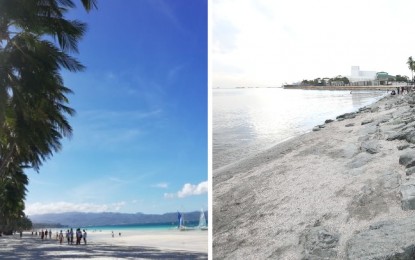
(PNA file photo of Boracay and Manila Bay)
MANILA – The government further pursued this year rehabilitation of world-famous tourist destination Boracay Island and historic Manila Bay, recovering the areas lost to encroachment and trash.
The anti-encroachment crackdown amid the rehabilitation in Boracay has resulted in the recovery of illegally occupied forestland, easements, and wetlands there, Department of Environment and Natural Resources (DENR) Secretary Roy Cimatu said.
"The rule of law is paramount and law enforcement is crucial and non-negotiable," he said in an earlier virtual presser on Boracay's DENR-led rehabilitation.
He said operations against nine establishments illegally occupying protected forestland in Boracay resulted in the filing of cases against the encroachers for violating Presidential Decree 705 (Revised Forestry Code of the Philippines) and Presidential Decree 1067 (The Water Code of the Philippines).
About 73 percent of 339 structures in Boracay complied with easement regulations, he noted.
"Of the nine wetlands there, we have recovered five -- these are wetland numbers 2,3,4,6, and 8," he said.
Recovering and restoring the wetlands are part of activities in addressing Boracay's environmental degradation, he noted.
"Wetlands are important to the island because these help reduce soil erosion and store water to minimize impacts of flooding," he said.
In April 2018, the government began Boracay Island's six-month closure so rehabilitation work can start without much interference.
The government re-opened Boracay in October that year, drawing the public's praise for rehabilitation work done there so far.
According to DENR, the government targets to finish Boracay Island's rehabilitation by May 2021.
Rehabilitation remains on track despite Boracay's temporary closure again as a precaution against coronavirus disease 2019 (Covid-19), DENR noted.
Meanwhile, the DENR-led rehabilitation for Manila Bay includes getting rid of the bay's accumulation of trash, recover the 500 meter-long stretch of the coast bordering the baywalk area to create a white sand beach.
That will give people the opportunity of experiencing an accessible white sand beach particularly if they cannot go to Boracay Island and other destinations having such natural features, DENR Undersecretary Benny Antiporda said.
"This is a positive action, a positive image for the country especially when many people are already experiencing anxiety attacks because of Covid-19," he said.
He said the government targets to finish the project this year.
Antiporda also allayed fears the white sand beach project will harm Manila Bay's marine environment.
The project poses no environmental harm since the white sand the government is using to create the beach is not synthetic material as critics alleged but crushed dolomite boulders, he noted.
"Dolomite's content is calcium carbonate which is also found in coral reefs so the sand we're using isn't foreign to Manila Bay's marine ecosystem," he said.
He also said the environment-friendly engineering intervention in the white sand beach area will prevent erosion of crushed boulders being laid.
Resorts have been using crushed dolomite for years to create white beaches, he said.
Antiporda believes nature is positively responding to the government's on-going rehabilitation work for Manila Bay.
The rehabilitation is making Manila Bay cleaner so the area is starting to become a haven for fish again, he said.
He said increasing the availability of fish is drawing to Manila Bay egrets searching for food.
"It's unlike before when fish hardly survived in Manila Bay because of too much pollution there," he added. (PNA)
